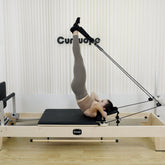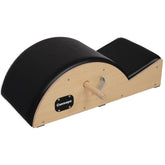How can Pilates Reformer be used to help patients with chronic diseases such as diabetes and hypertension?
Chronic diseases such as diabetes and hypertension affect millions of people worldwide and can have significant impacts on daily life. In addition to medication and other conventional treatments, exercise is an important component of managing chronic diseases. Pilates Reformer is a form of exercise that combines resistance training with stretching and controlled movements and may be beneficial for individuals with chronic diseases. In this article, we will explore the potential benefits of Pilates Reformer for patients with diabetes and hypertension.

What is Pilates Reformer?
Pilates Reformer is a form of exercise that involves a machine called a Reformer, which consists of a sliding carriage, springs, and pulleys. The Reformer is used to perform a series of controlled movements and exercises that are designed to improve strength, flexibility, balance, and posture. Pilates Reformer is a low-impact form of exercise that is suitable for individuals of all fitness levels and can be adapted to meet the needs of individuals with injuries or physical limitations.
Benefits of Pilates Reformer for Patients with Diabetes:
- Improved blood glucose control: Regular exercise, including Pilates Reformer, can help improve blood glucose control in individuals with diabetes. Studies have shown that Pilates Reformer can improve insulin sensitivity and glucose uptake in muscles, leading to better blood glucose control.
- Improved cardiovascular health: Diabetes increases the risk of cardiovascular disease, and regular exercise can help reduce this risk. Pilates Reformer provides a low-impact form of cardiovascular exercise that can improve heart health and reduce the risk of complications associated with diabetes.
- Improved muscle strength and flexibility: Diabetes can lead to muscle weakness and reduced flexibility, which can make daily activities more difficult. Pilates Reformer can improve muscle strength and flexibility, making it easier to perform daily activities and reducing the risk of falls and other injuries.
Benefits of Pilates Reformer for Patients with Hypertension:
- Reduced blood pressure: Regular exercise, including Pilates Reformer, can help reduce blood pressure in individuals with hypertension. Studies have shown that Pilates Reformer can lead to significant reductions in both systolic and diastolic blood pressure.
- Improved cardiovascular health: Hypertension increases the risk of cardiovascular disease, and regular exercise can help reduce this risk. Pilates Reformer provides a low-impact form of cardiovascular exercise that can improve heart health and reduce the risk of complications associated with hypertension.
- Reduced stress: Stress can contribute to hypertension, and Pilates Reformer is a form of exercise that promotes relaxation and reduces stress levels. Reducing stress through Pilates Reformer may help individuals with hypertension better manage their condition.
Conclusion:
Pilates Reformer is a low-impact form of exercise that combines resistance training with stretching and controlled movements. There is evidence to suggest that Pilates Reformer may be beneficial for patients with chronic diseases such as diabetes and hypertension. For individuals with diabetes, Pilates Reformer may help improve blood glucose control, cardiovascular health, muscle strength, and flexibility. For individuals with hypertension, Pilates Reformer may help reduce blood pressure, improve cardiovascular health, and reduce stress levels. As always, it is important to consult with your healthcare provider before beginning any new exercise program.





